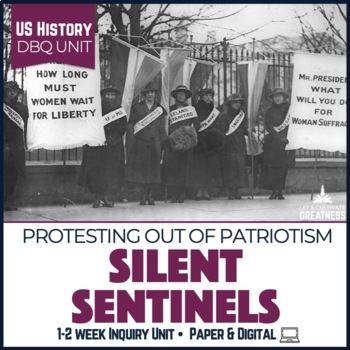Silent Sentinels Suffrage Movement DBQ Unit Print & Digital
- Zip
- Google Apps™

What educators are saying
Description
Challenge students to dive deeper and think beyond themselves in this point-of-view focused unit on the women suffrage movement’s final act: Alice Paul and the Silent Sentinels' impatient bravery and steadfast dedication to the American value of equality that finally brought women the 19th Amendment's right to vote.
This unit covers
- Founders' views on First Amendment rights
- Landmark Supreme Court on free speech
- Recent protest movements
- The backstory of women's suffrage prior to 1917
- Silent Sentinels 2 1/2 year protest effort
This unit strengthens core skills like
- Analyzing photo and written primary sources and evaluating for the effectiveness of protest strategies
- Empathizing with different points of view and deciding own views
- Writing an evidence-supported argumentative essay
This unit comes in two versions: paper PDF and digital for Google Slides.
************************************
Greatness is choosing effective strategies for speaking out when it matters most.
America was birthed from the ultimate protest- an outright rebellion- and we couldn’t be prouder. Many of our greatest national heroes were unceasing protesters. Yet, today, we seem to grumble at those in the streets for their disruption. Why is that so?
Introduce your students to this group who used unprecedented, clever-yet-searing strategies to successfully persuade lawmakers to change the law and challenge them to answer, “How patriotic were their protests?”
Leave the boring textbook behind and head straight to the compelling sources that make this question central to our pride and identity as Americans, and engage your students to create their own meaning of protest and patriotism.
This mini-unit can be done well in 1-2 weeks.
Included in this complete DBQ mini-unit:
Overview
- Teacher Unit Overview with general notes, links, standards, and a pacing guide
- Daily Lesson Plans with step-by-step details, planning, and lesson takeaway notes
- Detailed Answer Keys for each activity
- PowerPoint file of images and student directions (can be easily converted to Google Slides)
- Student Unit Notes sheet for building deep and nuanced mastery of concepts over the course of the unit using powerful graphic organizers
- Student Skill Handouts including Deciding a Precise Position, Creating a Thesis Statement, Including Evidence
Student Activities
- Quote Speed Dating start the conversation about how protest, free speech, and patriotism have been defined in America
- Founding Thoughts analyze the Founding Fathers’ and the Supreme Court’s positions on free speech
- Silent Sentinels Photos & Excerpts learn the story of this persistent and largely unknown group who brought the 19th Amendment to fruition
- 2017 Women's March compare strategies and analyze choices made by protesters in this modern-day protest
Summative Assessment
- End-of-Unit Essay support your students with detailed instructions, outline template, sentence stems, step-by-step PPT slides, and rubrics, that encapsulates their complete understanding by answering the not-so-simple question, “How patriotic were the Silent Sentinels?”
************************************
Want more Protest resources?
1900s Protest Movements PBL Unit: thematically teach this compelling American topic
Sit-In Movement DBQ Mini-Unit: round out your Civil Rights Movement unit with this in-depth inquiry
Free Speech Protest Sign Project: strengthen any protest unit from Abolition to Vietnam War
Boycott / “Buycott” Business Letter Project: pair with any activism topic
Want more U.S. History PBL Units?
Six Degrees of Separation: kick off a study of our country’s geography with a “Flat Stanley” style project
1600-1800s American Values: explore the founders of America, from the Puritans to the Nez Perce, and their core values in order to develop one’s own goal and motivational plan of action for the school year
1900s American Immigration: explore the American story of diversity and hard work through the words and statistics of immigrants, Ellis Island to Angel Island, to create and preserve an oral history of their own
1900s American Heroes: explore what it means to be a hero from Madam CJ Walker to John Glenn in order to nominate one’s own hero for recognition
Want to go entirely PBL?
U.S. History PBL Course Mega Bundle: get all U.S. History PBL resources in one download and save big!
This listing is for one license for regular, non-commercial classroom use by a single teacher only. In upholding copyright law, PDF resources are uneditable and resources made for Google Classroom have some editing abilities. By purchasing a license to this resource, you have access to all future updates at no cost, available under “My Purchases". Multiple and transferable licenses are available for purchase. To request a complete terms of use prior to purchase or if you have any questions about this resource, please leave a question below under Product Q&A.





